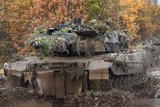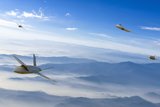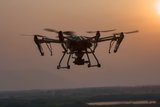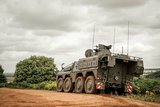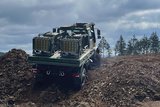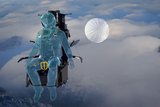Life-saving T4 robot in the spotlight (sponsored)
This article is brought to you by L3Harris Technologies.
Complex military missions can often put troops in considerable danger. Whether it’s hazardous materials (HAZMAT) clean-up, chemical, biological, radiological, nuclear and explosives (CBRNE) detection, or explosive ordnance disposal (EOD) missions, service people put their lives on the line every single day in their efforts to make the world a better place.
Robotics clearly plays a critical role in keeping military personnel safe, and large robots such as L3Harris Technologies’ T7 are often called upon to complete dangerous tasks to keep soldiers out of harm’s way. In fact, 122 T7 unmanned ground vehicles (UGVs) were recently delivered to the UK Ministry of Defence (MoD) for their STARTER program to replace their existing aging fleet, and are now being deployed for missions both within the UK and abroad.
Despite their many benefits, however, from impressive arm strength to long reach, larger robots aren’t always the most appropriate choice. Some often require the help of multiple individuals for transportation and setup, as well as a large area for storage. Likewise, large robots are not best suited to operation within tighter spaces. Medium-sized robots are more easily transported and able to access smaller spaces; seemingly an ideal solution.
The issue is that historically medium-sized robots just didn’t have the capability to succeed against demanding EOD tasks. Manipulator reach, high power EOD disruptors, and fewer payload capabilities simply didn’t enable the medium platforms to succeed often enough. That is, until now.

The T4 ushers in a new era for robotics
L3Harris’ T4 robot offers large robot capabilities in a medium-sized package. Weighing in at just over 100kg, the T4 outperforms all other medium-sized robots, as well as many large ones. It can be transported with ease, and rapidly broken down into subsystems to be carried by two people. Incredibly capable, the T4 robot’s best-in-class manipulator reach and superior strength set it apart from others in its weight class, able to perform tasks previously beyond the scope of a medium robot.
The world’s first medium-sized robot to offer haptic force feedback, the T4 allows the user to physically “feel” what its robot arm is doing or feeling, enabling mission-critical precision and human-like dexterity during complex tasks. Operating the robot feels as natural as moving one’s own hand. Highly intuitive control and an intelligent user interface enables rapid completion of demanding and intricate jobs, such as unzipping bags and opening small compartments like glove boxes, keeping operators out of harm’s way and maximising mission effectiveness.
The T4 is able to fire the highest power EOD disruptors of any medium-sized robot, such as HOTROD and PIGSTICK. Its patented recoil-absorbing system reduces recoil forces to its arm by an astounding 90%, allowing it to fire repeatedly with maximum disruptive effect and no robot damage. Hardened against electromagnetic interference (EMI) due to its robust aerospace-grade design, the robot is also optimised to operate alongside powerful electronic countermeasures (ECM) without disruption.
Extremely mobile and manoeuvrable, thanks to a unique stabiliser design and an all-terrain, all-weather track system, the T4 provides unparalleled, uncompromised performance. What’s more, its ruggedized design ensures it thrives in even the harshest of environments, so whether faced with sand, snow, mud, staircases, or water, it’s ready for any challenge. Multiple mission-specific attachments, sensors, and payloads and a simple interface mean the T4 is able to rapidly adapt to evolving threats and changing missions, both now and in the future.

Robots that reduce the cognitive burden
As the T4 robot is built on the foundations of the T7 system, it shares several of the same features and capabilities as its predecessor. The most important of these is that the unique haptic force feedback grip controller is compatible with both systems. This means operator cognitive burden is substantially reduced and required training is streamlined and minimised. Operators can even switch between the robots during missions using a single controller, meaning both systems can be used simultaneously. Deployment, support, and repair of the robots, too, is made much simpler, as the T4 and T7 share many common parts.

In the meantime, you can discover more about the T4 here: https://bit.ly/3i5pNWX
More from Industry Spotlights
-
![The future is here: Sixth-gen air dominance]()
The future is here: Sixth-gen air dominance
How RTX is equipping the military airspace – for today’s fleet and tomorrow’s fight.
-
![De-Risking the Future: Manufacturing Certainty for Unmanned Systems]()
De-Risking the Future: Manufacturing Certainty for Unmanned Systems
How strategic manufacturing partnership solves the industrialisation triad — Scale, Compliance and Cost — for hyper-growth defence tech innovators.
-
![Battlefield mobility, made in the UK]()
Battlefield mobility, made in the UK
How does Britain ensure that we can preserve the lives of our soldiers and allies – now and in the future – with homegrown innovation and resilient domestic manufacturing? At Pearson Engineering, we are proud to be a central part of the answer to this increasingly important question.
-
![Strengthening Baltic defence capabilities]()
Strengthening Baltic defence capabilities
How Latvia is bolstering its territorial defences, industrial capacity and international cooperation with Dynamit Nobel Defence’s SKORPION2 Remote Mining System.
-
![Barco’s vision to trust: from past to future]()
Barco’s vision to trust: from past to future
Barco’s story is one of constant evolution enabling more immersive, reliable, and future-ready training experiences.
-
![How are next-generation ejection seats helping pilots when they need it most?]()
How are next-generation ejection seats helping pilots when they need it most?
The ACES 5 ejection seat from RTX’s Collins Aerospace introduces new, innovative and patented technologies to help save lives.










